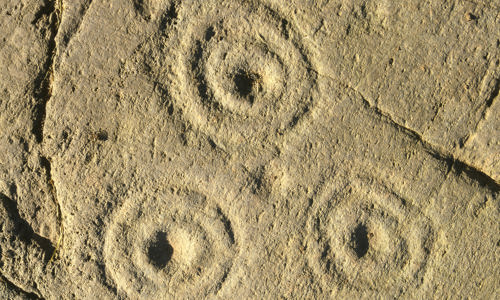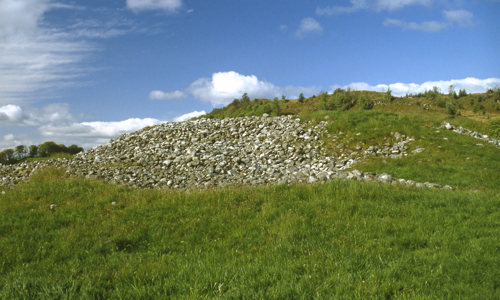History
Temple Wood Stone Circle was in use for some 2,000 years, from the Neolithic period through to the Bronze Age. In that time the site was developed and re-used.
Ritual ceremony
The earliest remains on the site indicate it was first used in about 3500–3000 BC, when a timber circle was built. Work began on a stone circle to replace the timber one, but was never finished.
In about 3000 BC an oval setting of 22 standing stones was built south-west of the timber circle. None is taller than 1.6m, and one is marked with a spiral motif –paralleled in Irish passage-grave art – which strongly suggests contact between Kilmartin and Ireland.
Later, the gaps between the individual stones were infilled with low interval slabs. The slabs were evidently designed to restrict access into the circle, but not the view from outside it.
Burial rites
In about 2000 BC the site became the focus of funerary activity, with the construction of two small burial cairns outside the stone circle. They were followed by more cist burials, covered with a mound of stones.
The area within the standing stones gradually became filled in, to form a burial cairn much like those in the nearby ‘linear cemetery’. The only item of human remains found here during excavation was a child’s tooth. Grave goods were found, including barbed-and-tanged arrowheads, a finely decorated Beaker, and yellow and red ochre.
A prehistoric landscape
A rich prehistoric landscape survives in Kilmartin Glen, providing a tantalising insight into its prehistoric population. The surviving rock art along the glen is remarkable for the number of elaborately carved outcrops, the style of and extent of the carvings, and their close association with other prehistoric monuments. No other place in Scotland has such a concentration of prehistoric carved stone surfaces, and Neolithic and Bronze Age monuments.
Other carved rock outcrops around Kilmartin Glen include:
Other monuments include:
- Dunadd Hill Fort
- Dunchraigaig Cairn
- Glebe Cairn
- Nether Largie North Cairn
- Nether Largie Mid Cairn
- Nether Largie South Cairn
- Ri-Cruin Cairn
The glen is also home to an important collection of medieval sculptured stones.










